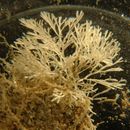Look Alikes
provided by Invertebrates of the Salish Sea
How to Distinguish from Similar Species: Of the bryozoans with erect branching colony and a biserial row of zooecia, Crisia pugeti and Crisia serrulata have an ooeciostome that is curved or bent forward. Crisia maxima has straight ooeciostomes the branches, rather than bending toward one another or ending with spikelike projections at their tips, are straight with long internodes. This species closely resembles Crisia eburnea from the Atlantic.
- license
- cc-by-nc-sa
- copyright
- Rosario Beach Marine Laboratory
Comprehensive Description
provided by Invertebrates of the Salish Sea
Biology/Natural History: Cyclostome bryozoans are mostly marine, have tubular, calcareous zooecia, and the aperture is usually circular. They have no operculum. Embryos develop in ovicells which are seen as swellings on the colony. The current created by the cilia in this species is surprisingly strong. I watched particles from a distance of 4-5x the length of the lophophore tentacles become entrained in the current, drawn toward the tentacles, and blown away again, all within about 1/2 second. This species does not have a long planktonic stage.
- license
- cc-by-nc-sa
- copyright
- Rosario Beach Marine Laboratory
Habitat
provided by Invertebrates of the Salish Sea
Attached
- license
- cc-by-nc-sa
- copyright
- Rosario Beach Marine Laboratory
Comprehensive Description
provided by Invertebrates of the Salish Sea
This bryozoan has an erect, branching colony with tubular, lightly calcified zooecia. The zooecia lie in 2 rows against one another, and have a circular aperture and no operculum. The ooecioistome is straight. The branches of the colony are jointed and curved slightly inward. Color is white or light tan.
- license
- cc-by-nc-sa
- copyright
- Rosario Beach Marine Laboratory
Distribution
provided by Invertebrates of the Salish Sea
Geographical Range: Abundant in San Francisco Bay. Found at least from Los Angeles to Puget Sound. Reported from Jamaica
- license
- cc-by-nc-sa
- copyright
- Rosario Beach Marine Laboratory
Habitat
provided by World Register of Marine Species
Known from seamounts and knolls
Stocks, K. 2009. Seamounts Online: an online information system for seamount biology. Version 2009-1. World Wide Web electronic publication.
- license
- cc-by-4.0
- copyright
- WoRMS Editorial Board

